Management Accounting Report: Financial Strategies for Sollatak Ltd
VerifiedAdded on 2020/11/23
|17
|5513
|474
Report
AI Summary
This report delves into the realm of management accounting, utilizing Sollatak Ltd, a technology company, as a case study to analyze its financial position and operational efficiency. It encompasses a detailed exploration of various management accounting systems, including cost accounting, price optimization, inventory management, and job costing, evaluating their benefits and applications. The report further examines different methods of management accounting reporting, such as performance reports, accounts receivable aging reports, inventory management reports, and job cost reporting, and their role in decision-making. It then proceeds to illustrate the preparation of income statements using marginal and absorption costing techniques, assessing their impact on financial reporting. Moreover, it explores budgetary control, its advantages and disadvantages, and the use of planning tools for forecasting. Finally, the report addresses the response of management accounting systems to financial problems, emphasizing how these systems can guide an organization towards sustainable success. The report's structure includes an introduction outlining the project's objectives, followed by four tasks that cover the core aspects of management accounting and its practical applications within Sollatak Ltd.
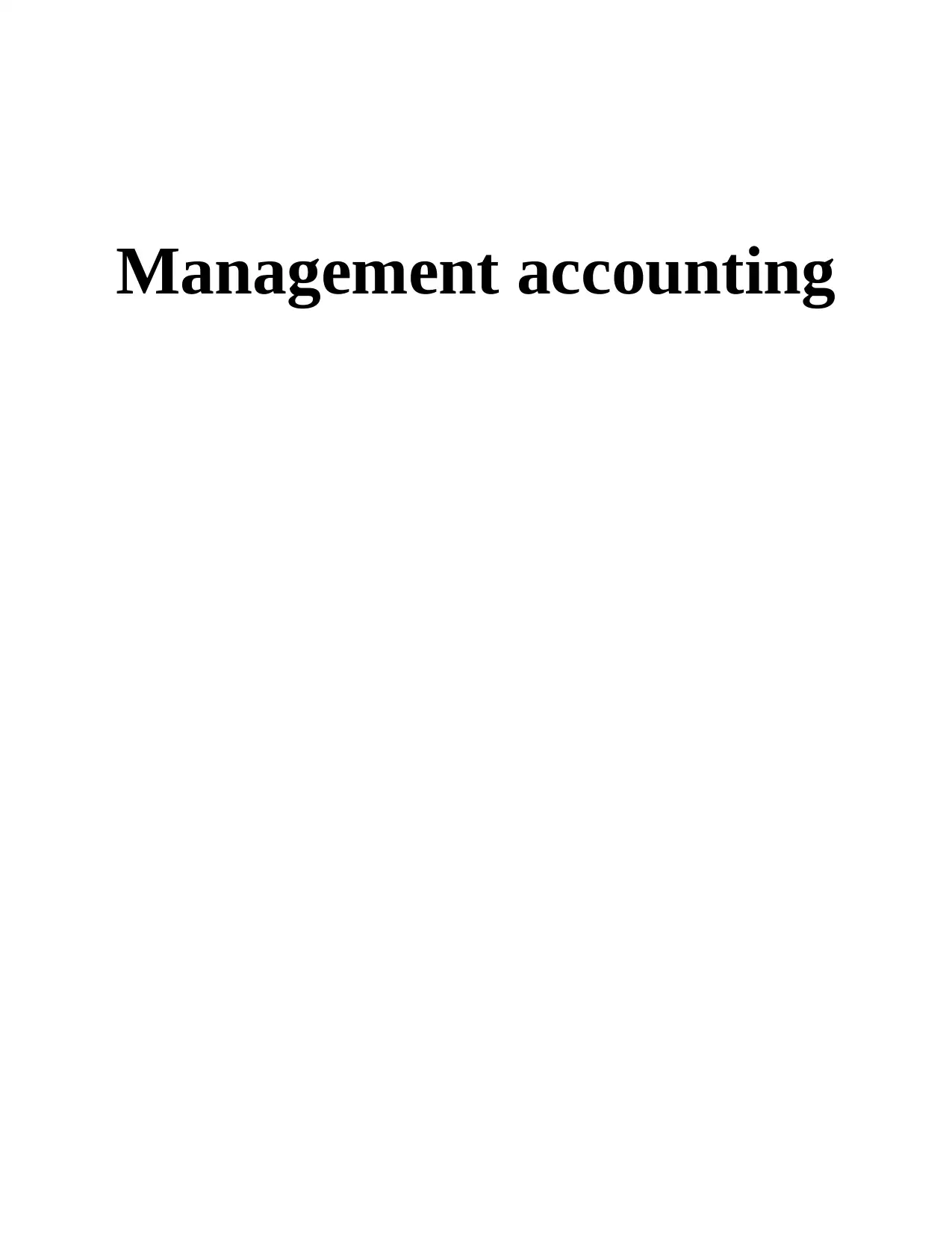
Management accounting
Paraphrase This Document
Need a fresh take? Get an instant paraphrase of this document with our AI Paraphraser

Table of Contents
INTRODUCTION...........................................................................................................................1
TASK 1............................................................................................................................................1
P1 Management accounting and its types of management accounting systems....................1
P2 Different methods used for management accounting reporting........................................3
M1 Evaluate the benefits of management accounting systems and its applications..............5
TASK 2............................................................................................................................................6
P3 Preparation of income statements by using cost techniques.............................................6
M2 Application of management accounting techniques to produce financial reporting
documents...............................................................................................................................8
D2 Financial resorts and interpretation of data of business activities....................................8
TASK 3............................................................................................................................................9
P4 Budgetary control and advantages and disadvantages of planning tools used in budgetary
control.....................................................................................................................................9
M3 Use of different management tools and their application for preparing and forecasting
budget...................................................................................................................................11
D3 Evaluation of planning tools to respond financial problems..........................................11
TASK 4..........................................................................................................................................11
P5 Response of management accounting system to financial problems..............................11
M4 In responding to financial problems management accounting can lead organisation to
sustainable success...............................................................................................................13
CONCLUSION..............................................................................................................................13
REFERENCES..............................................................................................................................14
INTRODUCTION...........................................................................................................................1
TASK 1............................................................................................................................................1
P1 Management accounting and its types of management accounting systems....................1
P2 Different methods used for management accounting reporting........................................3
M1 Evaluate the benefits of management accounting systems and its applications..............5
TASK 2............................................................................................................................................6
P3 Preparation of income statements by using cost techniques.............................................6
M2 Application of management accounting techniques to produce financial reporting
documents...............................................................................................................................8
D2 Financial resorts and interpretation of data of business activities....................................8
TASK 3............................................................................................................................................9
P4 Budgetary control and advantages and disadvantages of planning tools used in budgetary
control.....................................................................................................................................9
M3 Use of different management tools and their application for preparing and forecasting
budget...................................................................................................................................11
D3 Evaluation of planning tools to respond financial problems..........................................11
TASK 4..........................................................................................................................................11
P5 Response of management accounting system to financial problems..............................11
M4 In responding to financial problems management accounting can lead organisation to
sustainable success...............................................................................................................13
CONCLUSION..............................................................................................................................13
REFERENCES..............................................................................................................................14
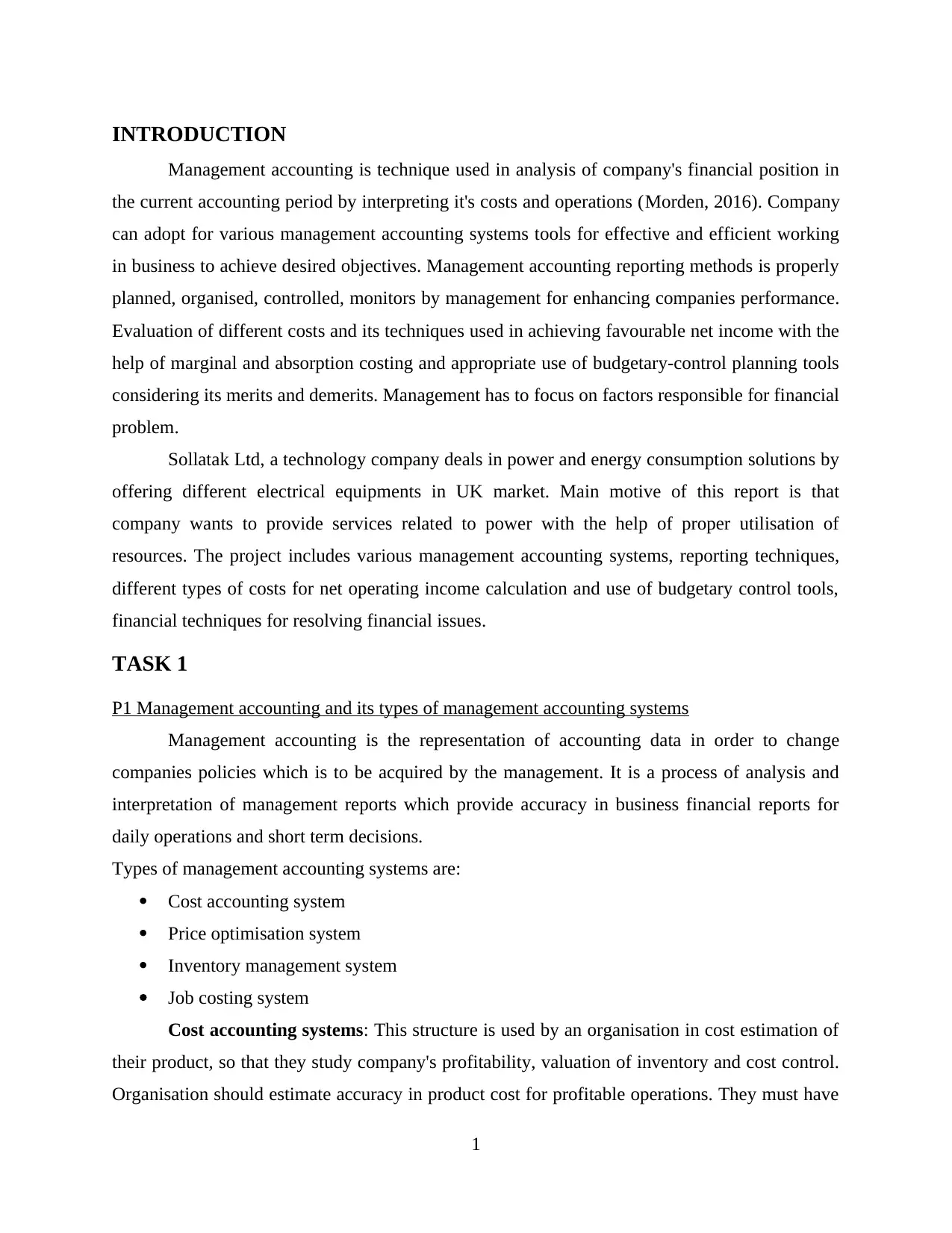
INTRODUCTION
Management accounting is technique used in analysis of company's financial position in
the current accounting period by interpreting it's costs and operations (Morden, 2016). Company
can adopt for various management accounting systems tools for effective and efficient working
in business to achieve desired objectives. Management accounting reporting methods is properly
planned, organised, controlled, monitors by management for enhancing companies performance.
Evaluation of different costs and its techniques used in achieving favourable net income with the
help of marginal and absorption costing and appropriate use of budgetary-control planning tools
considering its merits and demerits. Management has to focus on factors responsible for financial
problem.
Sollatak Ltd, a technology company deals in power and energy consumption solutions by
offering different electrical equipments in UK market. Main motive of this report is that
company wants to provide services related to power with the help of proper utilisation of
resources. The project includes various management accounting systems, reporting techniques,
different types of costs for net operating income calculation and use of budgetary control tools,
financial techniques for resolving financial issues.
TASK 1
P1 Management accounting and its types of management accounting systems
Management accounting is the representation of accounting data in order to change
companies policies which is to be acquired by the management. It is a process of analysis and
interpretation of management reports which provide accuracy in business financial reports for
daily operations and short term decisions.
Types of management accounting systems are:
Cost accounting system
Price optimisation system
Inventory management system
Job costing system
Cost accounting systems: This structure is used by an organisation in cost estimation of
their product, so that they study company's profitability, valuation of inventory and cost control.
Organisation should estimate accuracy in product cost for profitable operations. They must have
1
Management accounting is technique used in analysis of company's financial position in
the current accounting period by interpreting it's costs and operations (Morden, 2016). Company
can adopt for various management accounting systems tools for effective and efficient working
in business to achieve desired objectives. Management accounting reporting methods is properly
planned, organised, controlled, monitors by management for enhancing companies performance.
Evaluation of different costs and its techniques used in achieving favourable net income with the
help of marginal and absorption costing and appropriate use of budgetary-control planning tools
considering its merits and demerits. Management has to focus on factors responsible for financial
problem.
Sollatak Ltd, a technology company deals in power and energy consumption solutions by
offering different electrical equipments in UK market. Main motive of this report is that
company wants to provide services related to power with the help of proper utilisation of
resources. The project includes various management accounting systems, reporting techniques,
different types of costs for net operating income calculation and use of budgetary control tools,
financial techniques for resolving financial issues.
TASK 1
P1 Management accounting and its types of management accounting systems
Management accounting is the representation of accounting data in order to change
companies policies which is to be acquired by the management. It is a process of analysis and
interpretation of management reports which provide accuracy in business financial reports for
daily operations and short term decisions.
Types of management accounting systems are:
Cost accounting system
Price optimisation system
Inventory management system
Job costing system
Cost accounting systems: This structure is used by an organisation in cost estimation of
their product, so that they study company's profitability, valuation of inventory and cost control.
Organisation should estimate accuracy in product cost for profitable operations. They must have
1
⊘ This is a preview!⊘
Do you want full access?
Subscribe today to unlock all pages.

Trusted by 1+ million students worldwide
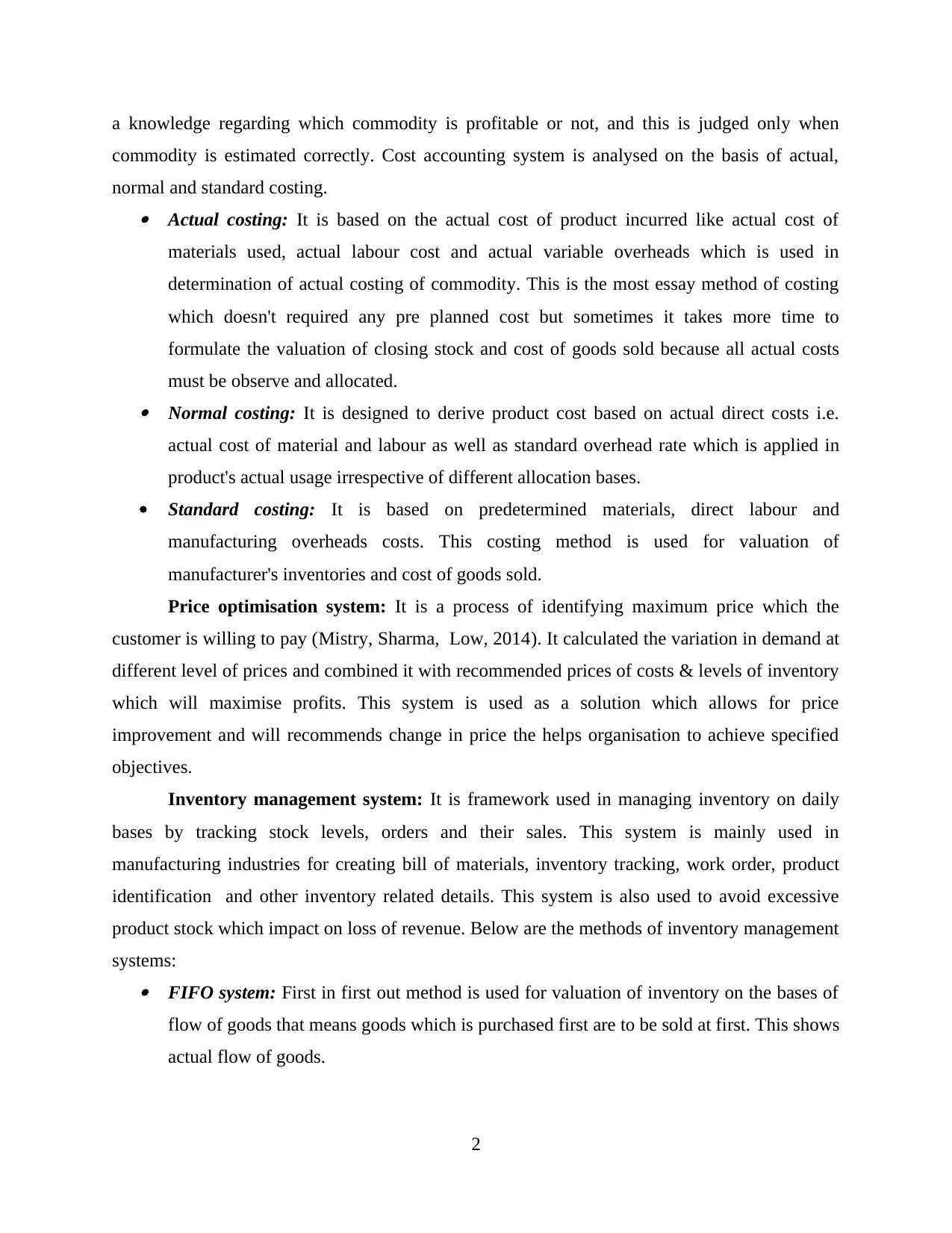
a knowledge regarding which commodity is profitable or not, and this is judged only when
commodity is estimated correctly. Cost accounting system is analysed on the basis of actual,
normal and standard costing. Actual costing: It is based on the actual cost of product incurred like actual cost of
materials used, actual labour cost and actual variable overheads which is used in
determination of actual costing of commodity. This is the most essay method of costing
which doesn't required any pre planned cost but sometimes it takes more time to
formulate the valuation of closing stock and cost of goods sold because all actual costs
must be observe and allocated. Normal costing: It is designed to derive product cost based on actual direct costs i.e.
actual cost of material and labour as well as standard overhead rate which is applied in
product's actual usage irrespective of different allocation bases.
Standard costing: It is based on predetermined materials, direct labour and
manufacturing overheads costs. This costing method is used for valuation of
manufacturer's inventories and cost of goods sold.
Price optimisation system: It is a process of identifying maximum price which the
customer is willing to pay (Mistry, Sharma, Low, 2014). It calculated the variation in demand at
different level of prices and combined it with recommended prices of costs & levels of inventory
which will maximise profits. This system is used as a solution which allows for price
improvement and will recommends change in price the helps organisation to achieve specified
objectives.
Inventory management system: It is framework used in managing inventory on daily
bases by tracking stock levels, orders and their sales. This system is mainly used in
manufacturing industries for creating bill of materials, inventory tracking, work order, product
identification and other inventory related details. This system is also used to avoid excessive
product stock which impact on loss of revenue. Below are the methods of inventory management
systems: FIFO system: First in first out method is used for valuation of inventory on the bases of
flow of goods that means goods which is purchased first are to be sold at first. This shows
actual flow of goods.
2
commodity is estimated correctly. Cost accounting system is analysed on the basis of actual,
normal and standard costing. Actual costing: It is based on the actual cost of product incurred like actual cost of
materials used, actual labour cost and actual variable overheads which is used in
determination of actual costing of commodity. This is the most essay method of costing
which doesn't required any pre planned cost but sometimes it takes more time to
formulate the valuation of closing stock and cost of goods sold because all actual costs
must be observe and allocated. Normal costing: It is designed to derive product cost based on actual direct costs i.e.
actual cost of material and labour as well as standard overhead rate which is applied in
product's actual usage irrespective of different allocation bases.
Standard costing: It is based on predetermined materials, direct labour and
manufacturing overheads costs. This costing method is used for valuation of
manufacturer's inventories and cost of goods sold.
Price optimisation system: It is a process of identifying maximum price which the
customer is willing to pay (Mistry, Sharma, Low, 2014). It calculated the variation in demand at
different level of prices and combined it with recommended prices of costs & levels of inventory
which will maximise profits. This system is used as a solution which allows for price
improvement and will recommends change in price the helps organisation to achieve specified
objectives.
Inventory management system: It is framework used in managing inventory on daily
bases by tracking stock levels, orders and their sales. This system is mainly used in
manufacturing industries for creating bill of materials, inventory tracking, work order, product
identification and other inventory related details. This system is also used to avoid excessive
product stock which impact on loss of revenue. Below are the methods of inventory management
systems: FIFO system: First in first out method is used for valuation of inventory on the bases of
flow of goods that means goods which is purchased first are to be sold at first. This shows
actual flow of goods.
2
Paraphrase This Document
Need a fresh take? Get an instant paraphrase of this document with our AI Paraphraser

LIFO system: Last in fast out method is also applicable for inventory valuation which
means goods purchases in last are sold at first. This system assigns the cost of new stock
to cost of goods sold and cost of first stock to closing stock account.
Prioritize with ABC: ABC analysis is used to prioritize company's inventory
management. In this system, company separates product which requires lot of
concentration with the products which don't required any attention.
Job Costing system: This system helps in tracking of expenses and maintaining
information used in unique product creation which is much related to business operations. In this
costing system cost of manufacturing job is recorded instead of process. Following are the types
of Job costing systems: Process costing: This costing method is used to identify the product cost at each level of
manufacturing. It helps in tracking that where the company's money is used in production
and distribution processes.
Contract costing: In this costing method company tracks their costs linked with a
customer in a way of specific contract. Generally, large scale construction company uses
this costing method of their businesses.
P2 Different methods used for management accounting reporting
Management accounting analyse company's reports for planning, implementing, decision
making and measures performance. Throughout the accounting period, these reports are
generated on regular basis as per the requirement of businesses. Many important decisions are
depend on the genuineness of these reports. These reports are generated & converted into useful
information for future references.
Following are the types of management accounting reports:
Performance report
Account receivable aging reports
inventory management reports
Job cost reporting
Performance report: This report is created to show the company's performance with
proper utilisation of resources within a specific period of time. This report compares actual
output with standard output and variation between these two for and whenever there is a
unfavourable variations the company is expected to take necessary actions. With the help of this
3
means goods purchases in last are sold at first. This system assigns the cost of new stock
to cost of goods sold and cost of first stock to closing stock account.
Prioritize with ABC: ABC analysis is used to prioritize company's inventory
management. In this system, company separates product which requires lot of
concentration with the products which don't required any attention.
Job Costing system: This system helps in tracking of expenses and maintaining
information used in unique product creation which is much related to business operations. In this
costing system cost of manufacturing job is recorded instead of process. Following are the types
of Job costing systems: Process costing: This costing method is used to identify the product cost at each level of
manufacturing. It helps in tracking that where the company's money is used in production
and distribution processes.
Contract costing: In this costing method company tracks their costs linked with a
customer in a way of specific contract. Generally, large scale construction company uses
this costing method of their businesses.
P2 Different methods used for management accounting reporting
Management accounting analyse company's reports for planning, implementing, decision
making and measures performance. Throughout the accounting period, these reports are
generated on regular basis as per the requirement of businesses. Many important decisions are
depend on the genuineness of these reports. These reports are generated & converted into useful
information for future references.
Following are the types of management accounting reports:
Performance report
Account receivable aging reports
inventory management reports
Job cost reporting
Performance report: This report is created to show the company's performance with
proper utilisation of resources within a specific period of time. This report compares actual
output with standard output and variation between these two for and whenever there is a
unfavourable variations the company is expected to take necessary actions. With the help of this
3
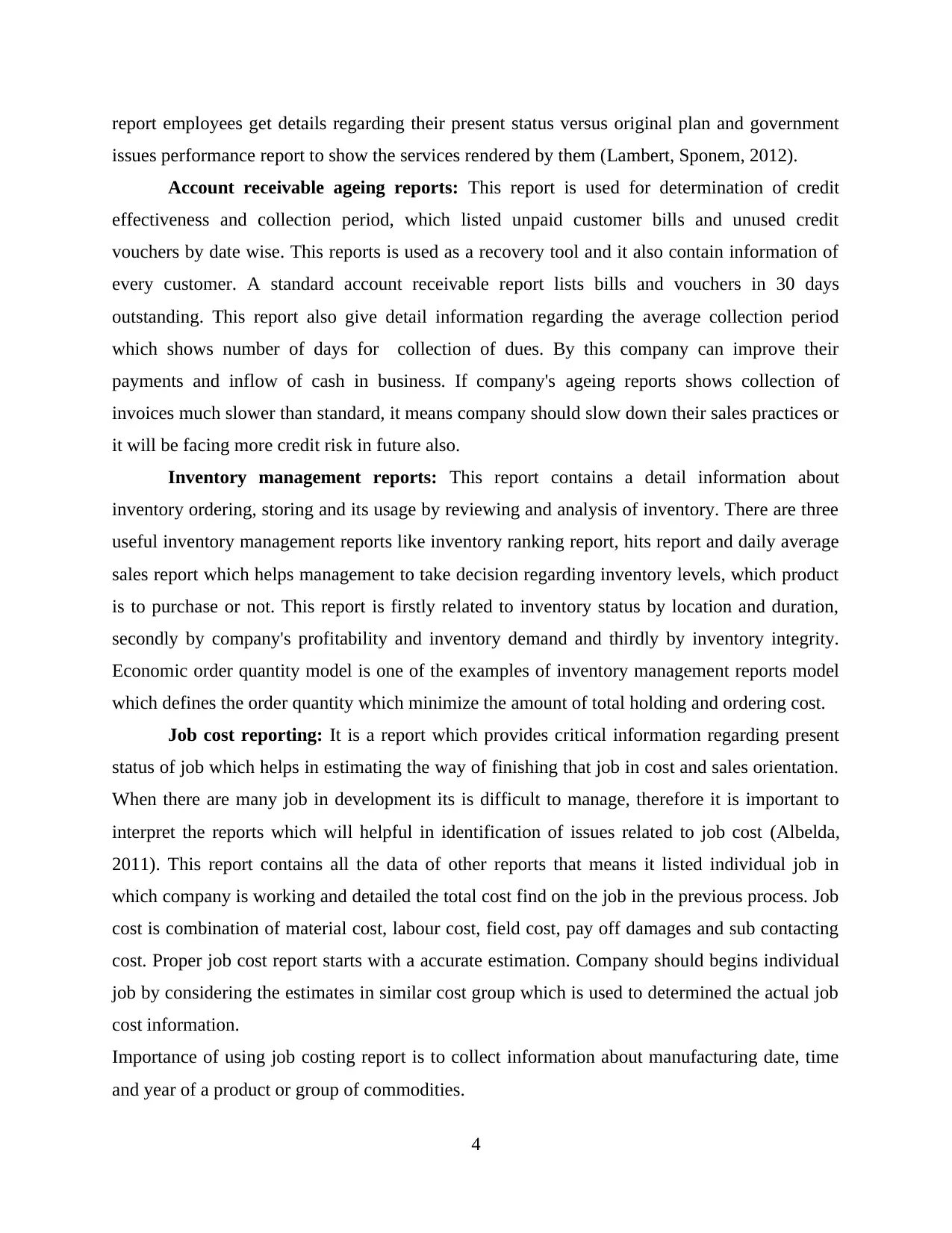
report employees get details regarding their present status versus original plan and government
issues performance report to show the services rendered by them (Lambert, Sponem, 2012).
Account receivable ageing reports: This report is used for determination of credit
effectiveness and collection period, which listed unpaid customer bills and unused credit
vouchers by date wise. This reports is used as a recovery tool and it also contain information of
every customer. A standard account receivable report lists bills and vouchers in 30 days
outstanding. This report also give detail information regarding the average collection period
which shows number of days for collection of dues. By this company can improve their
payments and inflow of cash in business. If company's ageing reports shows collection of
invoices much slower than standard, it means company should slow down their sales practices or
it will be facing more credit risk in future also.
Inventory management reports: This report contains a detail information about
inventory ordering, storing and its usage by reviewing and analysis of inventory. There are three
useful inventory management reports like inventory ranking report, hits report and daily average
sales report which helps management to take decision regarding inventory levels, which product
is to purchase or not. This report is firstly related to inventory status by location and duration,
secondly by company's profitability and inventory demand and thirdly by inventory integrity.
Economic order quantity model is one of the examples of inventory management reports model
which defines the order quantity which minimize the amount of total holding and ordering cost.
Job cost reporting: It is a report which provides critical information regarding present
status of job which helps in estimating the way of finishing that job in cost and sales orientation.
When there are many job in development its is difficult to manage, therefore it is important to
interpret the reports which will helpful in identification of issues related to job cost (Albelda,
2011). This report contains all the data of other reports that means it listed individual job in
which company is working and detailed the total cost find on the job in the previous process. Job
cost is combination of material cost, labour cost, field cost, pay off damages and sub contacting
cost. Proper job cost report starts with a accurate estimation. Company should begins individual
job by considering the estimates in similar cost group which is used to determined the actual job
cost information.
Importance of using job costing report is to collect information about manufacturing date, time
and year of a product or group of commodities.
4
issues performance report to show the services rendered by them (Lambert, Sponem, 2012).
Account receivable ageing reports: This report is used for determination of credit
effectiveness and collection period, which listed unpaid customer bills and unused credit
vouchers by date wise. This reports is used as a recovery tool and it also contain information of
every customer. A standard account receivable report lists bills and vouchers in 30 days
outstanding. This report also give detail information regarding the average collection period
which shows number of days for collection of dues. By this company can improve their
payments and inflow of cash in business. If company's ageing reports shows collection of
invoices much slower than standard, it means company should slow down their sales practices or
it will be facing more credit risk in future also.
Inventory management reports: This report contains a detail information about
inventory ordering, storing and its usage by reviewing and analysis of inventory. There are three
useful inventory management reports like inventory ranking report, hits report and daily average
sales report which helps management to take decision regarding inventory levels, which product
is to purchase or not. This report is firstly related to inventory status by location and duration,
secondly by company's profitability and inventory demand and thirdly by inventory integrity.
Economic order quantity model is one of the examples of inventory management reports model
which defines the order quantity which minimize the amount of total holding and ordering cost.
Job cost reporting: It is a report which provides critical information regarding present
status of job which helps in estimating the way of finishing that job in cost and sales orientation.
When there are many job in development its is difficult to manage, therefore it is important to
interpret the reports which will helpful in identification of issues related to job cost (Albelda,
2011). This report contains all the data of other reports that means it listed individual job in
which company is working and detailed the total cost find on the job in the previous process. Job
cost is combination of material cost, labour cost, field cost, pay off damages and sub contacting
cost. Proper job cost report starts with a accurate estimation. Company should begins individual
job by considering the estimates in similar cost group which is used to determined the actual job
cost information.
Importance of using job costing report is to collect information about manufacturing date, time
and year of a product or group of commodities.
4
⊘ This is a preview!⊘
Do you want full access?
Subscribe today to unlock all pages.

Trusted by 1+ million students worldwide
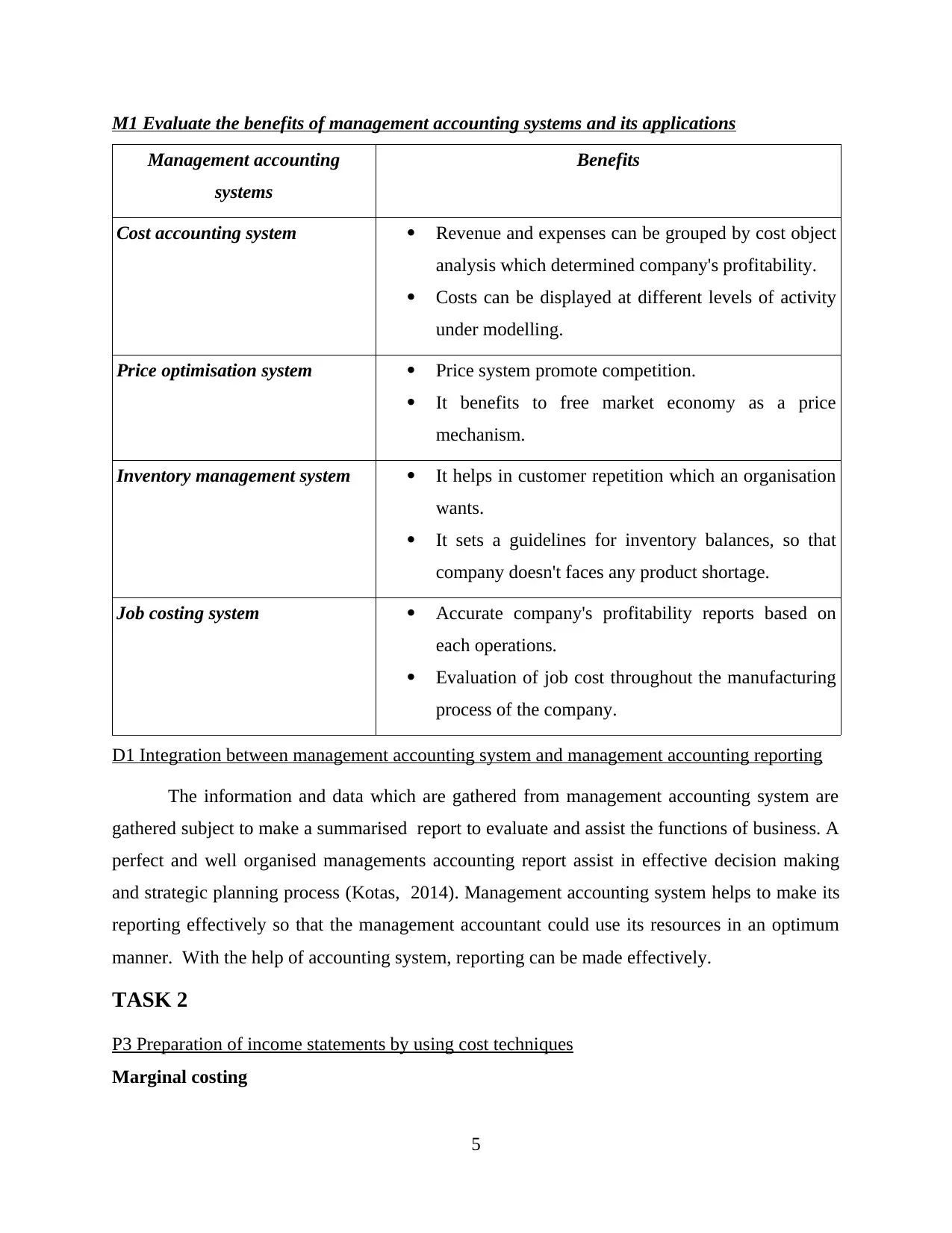
M1 Evaluate the benefits of management accounting systems and its applications
Management accounting
systems
Benefits
Cost accounting system Revenue and expenses can be grouped by cost object
analysis which determined company's profitability.
Costs can be displayed at different levels of activity
under modelling.
Price optimisation system Price system promote competition.
It benefits to free market economy as a price
mechanism.
Inventory management system It helps in customer repetition which an organisation
wants.
It sets a guidelines for inventory balances, so that
company doesn't faces any product shortage.
Job costing system Accurate company's profitability reports based on
each operations.
Evaluation of job cost throughout the manufacturing
process of the company.
D1 Integration between management accounting system and management accounting reporting
The information and data which are gathered from management accounting system are
gathered subject to make a summarised report to evaluate and assist the functions of business. A
perfect and well organised managements accounting report assist in effective decision making
and strategic planning process (Kotas, 2014). Management accounting system helps to make its
reporting effectively so that the management accountant could use its resources in an optimum
manner. With the help of accounting system, reporting can be made effectively.
TASK 2
P3 Preparation of income statements by using cost techniques
Marginal costing
5
Management accounting
systems
Benefits
Cost accounting system Revenue and expenses can be grouped by cost object
analysis which determined company's profitability.
Costs can be displayed at different levels of activity
under modelling.
Price optimisation system Price system promote competition.
It benefits to free market economy as a price
mechanism.
Inventory management system It helps in customer repetition which an organisation
wants.
It sets a guidelines for inventory balances, so that
company doesn't faces any product shortage.
Job costing system Accurate company's profitability reports based on
each operations.
Evaluation of job cost throughout the manufacturing
process of the company.
D1 Integration between management accounting system and management accounting reporting
The information and data which are gathered from management accounting system are
gathered subject to make a summarised report to evaluate and assist the functions of business. A
perfect and well organised managements accounting report assist in effective decision making
and strategic planning process (Kotas, 2014). Management accounting system helps to make its
reporting effectively so that the management accountant could use its resources in an optimum
manner. With the help of accounting system, reporting can be made effectively.
TASK 2
P3 Preparation of income statements by using cost techniques
Marginal costing
5
Paraphrase This Document
Need a fresh take? Get an instant paraphrase of this document with our AI Paraphraser

In minimal costing, costs are isolated into two sections variable cost and settled cost.
Peripheral cost is the added substance cost of the additional unit which will be delivered by the
organization. Minimal costing is utilized to choose the best amount for the additional unit and
furthermore, it cost less to deliver the extra unit. Peripheral cost is utilized as a part of
administration basic leadership. Negligible cost is ordinarily near normal cost (RKlychova,
Faskhutdinova, Sadrieva, 2014). Yet, in tremendous businesses with higher speculation, there is
minor cost is similarly downgraded with normal cost. Minor cost is otherwise called differential
cost or incremental cost or added substance cost. With the help of marginal costing, and
absorption costing, management of Sollatak Ltd could optimise their profits.
Calculation of net profit by using marginal costing method
Particulars Amount
Sales revenue = (selling price * no. of goods sold = 55 * 600) 33000
Marginal Cost of goods sold: 9600
Production = (units produced * marginal cost per unit = 800 * 16) 12800
closing stock = (closing stock units * marginal cost per unit = 200 * 16) 3200
Contribution 23400
Fixed cost ( 3200+1200+1500 ) 5900
Net profit 17500
Absorption costing
Absorption costing guarantee that every one of the costs encased underway will be
mended from the gross income of the item or administration. Retention costing assist
organizations with uncovering wasteful aspects in store network as organization wanted to watch
that it is working with most extreme proficiency (Schaltegger, Zvezdov, 2011). In this technique,
cost per unit remain same if the creation units are same however in the event that there is an
adjustment underway units at that point cost per unit will likewise changed, yet settled cost will
dependably remain constant.
Computation of net income by using absorption costing method:
Particulars Amount
Sales = (selling price * no. of units sold = 55 * 600) 33000
Cost of goods sold = (total expenses per unit * actual sales = 23.375 * 600) 14025
Gross profit 18975
Selling & Administrative expenses = (variable sales overhead * actual sales +
selling and administrative cost = 1 * 600 + 2700) 3300
Net profit/ operating income 15675
6
Peripheral cost is the added substance cost of the additional unit which will be delivered by the
organization. Minimal costing is utilized to choose the best amount for the additional unit and
furthermore, it cost less to deliver the extra unit. Peripheral cost is utilized as a part of
administration basic leadership. Negligible cost is ordinarily near normal cost (RKlychova,
Faskhutdinova, Sadrieva, 2014). Yet, in tremendous businesses with higher speculation, there is
minor cost is similarly downgraded with normal cost. Minor cost is otherwise called differential
cost or incremental cost or added substance cost. With the help of marginal costing, and
absorption costing, management of Sollatak Ltd could optimise their profits.
Calculation of net profit by using marginal costing method
Particulars Amount
Sales revenue = (selling price * no. of goods sold = 55 * 600) 33000
Marginal Cost of goods sold: 9600
Production = (units produced * marginal cost per unit = 800 * 16) 12800
closing stock = (closing stock units * marginal cost per unit = 200 * 16) 3200
Contribution 23400
Fixed cost ( 3200+1200+1500 ) 5900
Net profit 17500
Absorption costing
Absorption costing guarantee that every one of the costs encased underway will be
mended from the gross income of the item or administration. Retention costing assist
organizations with uncovering wasteful aspects in store network as organization wanted to watch
that it is working with most extreme proficiency (Schaltegger, Zvezdov, 2011). In this technique,
cost per unit remain same if the creation units are same however in the event that there is an
adjustment underway units at that point cost per unit will likewise changed, yet settled cost will
dependably remain constant.
Computation of net income by using absorption costing method:
Particulars Amount
Sales = (selling price * no. of units sold = 55 * 600) 33000
Cost of goods sold = (total expenses per unit * actual sales = 23.375 * 600) 14025
Gross profit 18975
Selling & Administrative expenses = (variable sales overhead * actual sales +
selling and administrative cost = 1 * 600 + 2700) 3300
Net profit/ operating income 15675
6
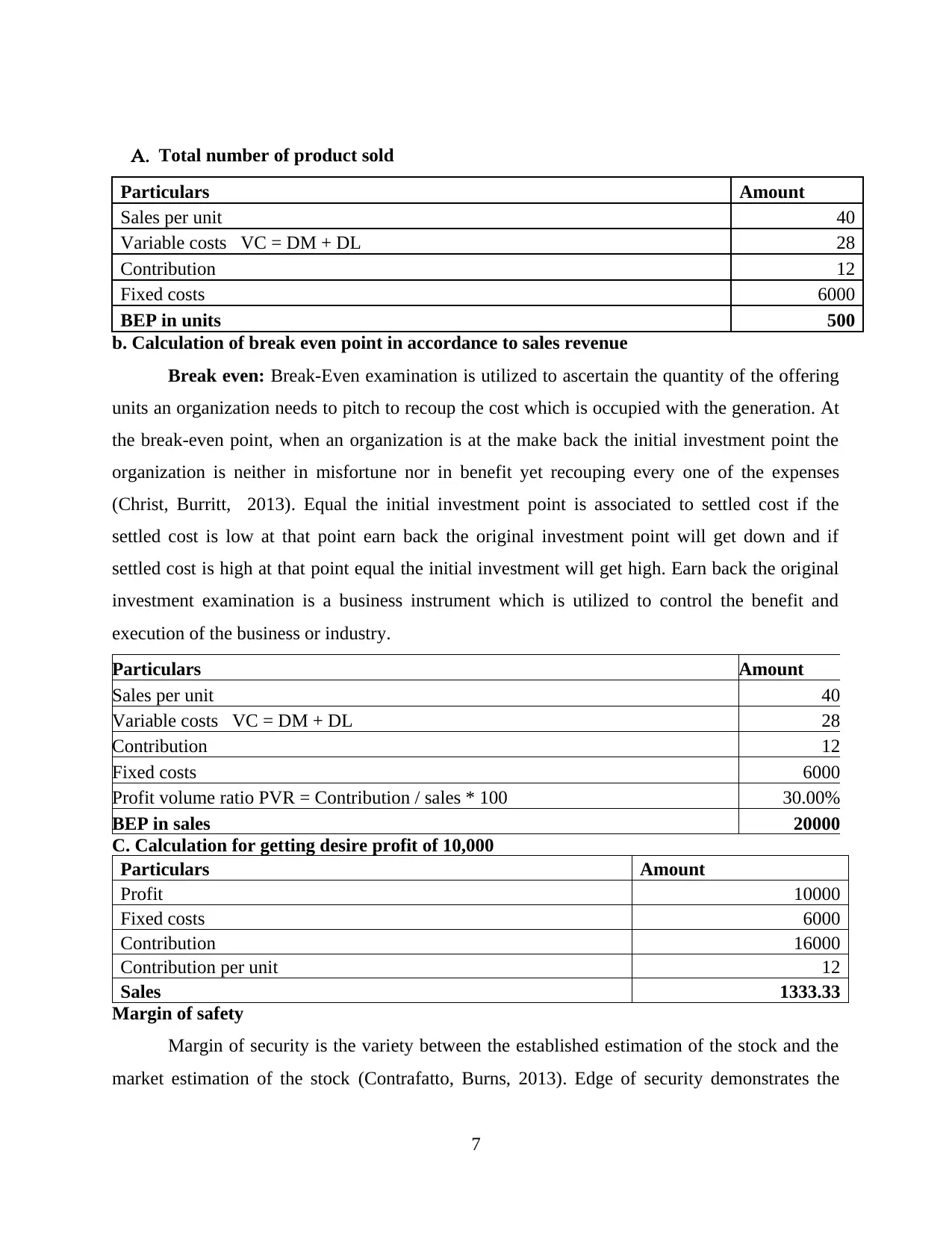
A. Total number of product sold
Particulars Amount
Sales per unit 40
Variable costs VC = DM + DL 28
Contribution 12
Fixed costs 6000
BEP in units 500
b. Calculation of break even point in accordance to sales revenue
Break even: Break-Even examination is utilized to ascertain the quantity of the offering
units an organization needs to pitch to recoup the cost which is occupied with the generation. At
the break-even point, when an organization is at the make back the initial investment point the
organization is neither in misfortune nor in benefit yet recouping every one of the expenses
(Christ, Burritt, 2013). Equal the initial investment point is associated to settled cost if the
settled cost is low at that point earn back the original investment point will get down and if
settled cost is high at that point equal the initial investment will get high. Earn back the original
investment examination is a business instrument which is utilized to control the benefit and
execution of the business or industry.
Particulars Amount
Sales per unit 40
Variable costs VC = DM + DL 28
Contribution 12
Fixed costs 6000
Profit volume ratio PVR = Contribution / sales * 100 30.00%
BEP in sales 20000
C. Calculation for getting desire profit of 10,000
Particulars Amount
Profit 10000
Fixed costs 6000
Contribution 16000
Contribution per unit 12
Sales 1333.33
Margin of safety
Margin of security is the variety between the established estimation of the stock and the
market estimation of the stock (Contrafatto, Burns, 2013). Edge of security demonstrates the
7
Particulars Amount
Sales per unit 40
Variable costs VC = DM + DL 28
Contribution 12
Fixed costs 6000
BEP in units 500
b. Calculation of break even point in accordance to sales revenue
Break even: Break-Even examination is utilized to ascertain the quantity of the offering
units an organization needs to pitch to recoup the cost which is occupied with the generation. At
the break-even point, when an organization is at the make back the initial investment point the
organization is neither in misfortune nor in benefit yet recouping every one of the expenses
(Christ, Burritt, 2013). Equal the initial investment point is associated to settled cost if the
settled cost is low at that point earn back the original investment point will get down and if
settled cost is high at that point equal the initial investment will get high. Earn back the original
investment examination is a business instrument which is utilized to control the benefit and
execution of the business or industry.
Particulars Amount
Sales per unit 40
Variable costs VC = DM + DL 28
Contribution 12
Fixed costs 6000
Profit volume ratio PVR = Contribution / sales * 100 30.00%
BEP in sales 20000
C. Calculation for getting desire profit of 10,000
Particulars Amount
Profit 10000
Fixed costs 6000
Contribution 16000
Contribution per unit 12
Sales 1333.33
Margin of safety
Margin of security is the variety between the established estimation of the stock and the
market estimation of the stock (Contrafatto, Burns, 2013). Edge of security demonstrates the
7
⊘ This is a preview!⊘
Do you want full access?
Subscribe today to unlock all pages.

Trusted by 1+ million students worldwide
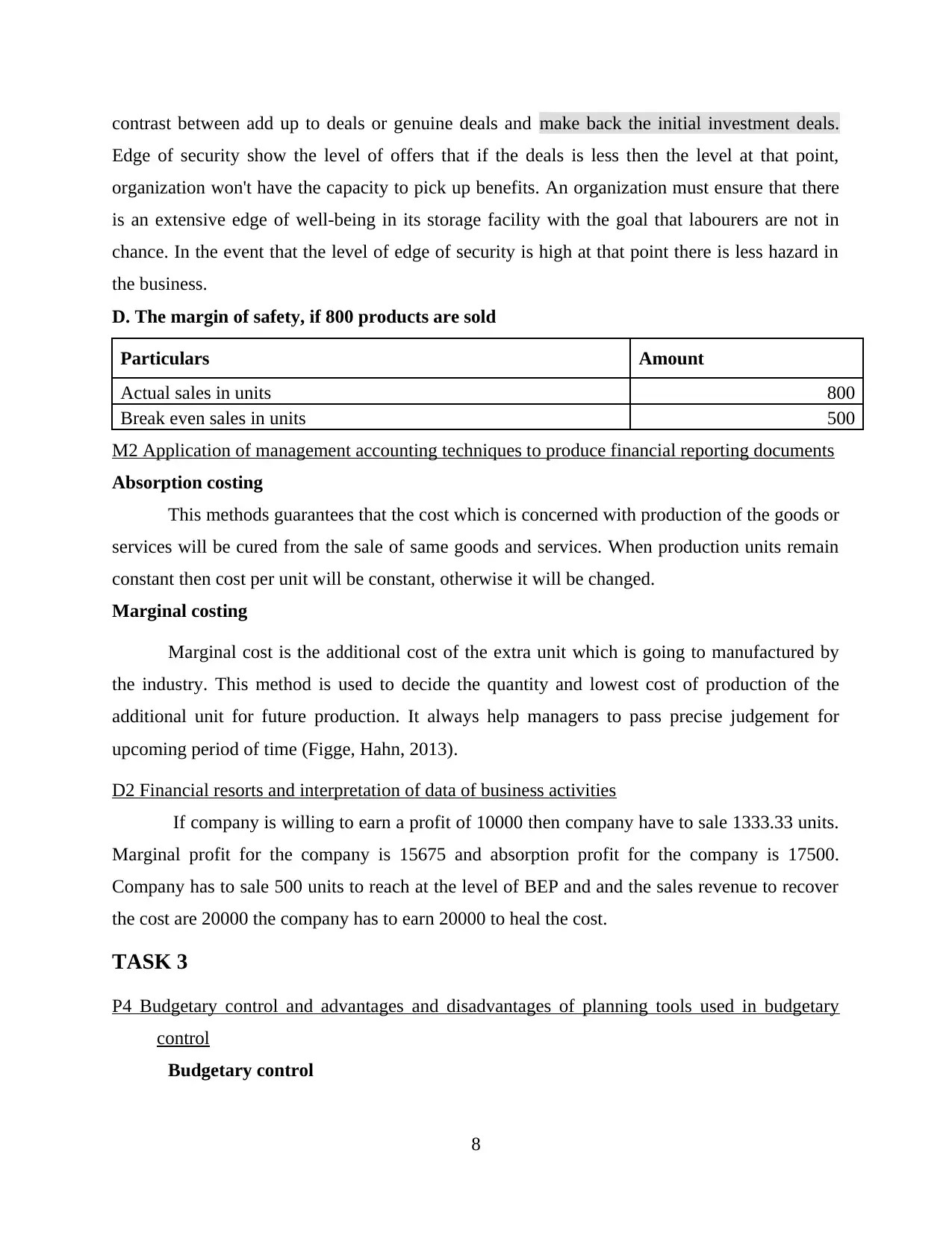
contrast between add up to deals or genuine deals and make back the initial investment deals.
Edge of security show the level of offers that if the deals is less then the level at that point,
organization won't have the capacity to pick up benefits. An organization must ensure that there
is an extensive edge of well-being in its storage facility with the goal that labourers are not in
chance. In the event that the level of edge of security is high at that point there is less hazard in
the business.
D. The margin of safety, if 800 products are sold
Particulars Amount
Actual sales in units 800
Break even sales in units 500
M2 Application of management accounting techniques to produce financial reporting documents
Absorption costing
This methods guarantees that the cost which is concerned with production of the goods or
services will be cured from the sale of same goods and services. When production units remain
constant then cost per unit will be constant, otherwise it will be changed.
Marginal costing
Marginal cost is the additional cost of the extra unit which is going to manufactured by
the industry. This method is used to decide the quantity and lowest cost of production of the
additional unit for future production. It always help managers to pass precise judgement for
upcoming period of time (Figge, Hahn, 2013).
D2 Financial resorts and interpretation of data of business activities
If company is willing to earn a profit of 10000 then company have to sale 1333.33 units.
Marginal profit for the company is 15675 and absorption profit for the company is 17500.
Company has to sale 500 units to reach at the level of BEP and and the sales revenue to recover
the cost are 20000 the company has to earn 20000 to heal the cost.
TASK 3
P4 Budgetary control and advantages and disadvantages of planning tools used in budgetary
control
Budgetary control
8
Edge of security show the level of offers that if the deals is less then the level at that point,
organization won't have the capacity to pick up benefits. An organization must ensure that there
is an extensive edge of well-being in its storage facility with the goal that labourers are not in
chance. In the event that the level of edge of security is high at that point there is less hazard in
the business.
D. The margin of safety, if 800 products are sold
Particulars Amount
Actual sales in units 800
Break even sales in units 500
M2 Application of management accounting techniques to produce financial reporting documents
Absorption costing
This methods guarantees that the cost which is concerned with production of the goods or
services will be cured from the sale of same goods and services. When production units remain
constant then cost per unit will be constant, otherwise it will be changed.
Marginal costing
Marginal cost is the additional cost of the extra unit which is going to manufactured by
the industry. This method is used to decide the quantity and lowest cost of production of the
additional unit for future production. It always help managers to pass precise judgement for
upcoming period of time (Figge, Hahn, 2013).
D2 Financial resorts and interpretation of data of business activities
If company is willing to earn a profit of 10000 then company have to sale 1333.33 units.
Marginal profit for the company is 15675 and absorption profit for the company is 17500.
Company has to sale 500 units to reach at the level of BEP and and the sales revenue to recover
the cost are 20000 the company has to earn 20000 to heal the cost.
TASK 3
P4 Budgetary control and advantages and disadvantages of planning tools used in budgetary
control
Budgetary control
8
Paraphrase This Document
Need a fresh take? Get an instant paraphrase of this document with our AI Paraphraser

It is the management control system in which existent and predicted income and expenses
are compared to get the knowledge that the plans are executed well or not or is there any
requirement to change the plan. It is a preparation activity of various functions of a business
which is done in advance so that operations of Sollatek (UK) remain controlled in proper
manner.
Process of Budgetary Control
Organisation Chart- Constitution of the organisation depend on the size and nature of
business units. It throws light on the duties of each member of the organisation so that
members can be familiar with their own perspective and in the administration and also
relationship with other members.
Budget Centre- It is an area of the organisation of an undertaking and is characterised
as such from component of aspect of budgetary control. It must be distinctly bounded
because a detached budget is to be closed up with the help of each of the department's
concern.
Budget Manual- It is a document which set out the obligation of the persons involved in
the workaday. This document guide the management to make new strategies for
budgetary control and helpful in getting idea of sensibility of the budget (Johnson,
2013).
Budget Committee- It is a group of individual executives like general manager,
production manager, sales manager, works manager etc. Managers have to perform all
the tasks which are applicable to their province. Budget committee has many obligations
like estimation of budget, execution of new policies, keep record of each and every
activity.
Budget Period- This the period in which the budget is preconditioned and engaged. It
depends on the type of enterprise, nature of the commodity, nature of demand and
provision, relation prospect etc. it can be a long term period or short term period depends
upon the nature of the product or service which is going to be produced by the
production unit.
Key Factor- It sets the boundary to the absolute state and determine the budget. It is
extremely momentous during calculation of production. Formerly there may be various
key factors like labour, raw material, capital, sales etc.
9
are compared to get the knowledge that the plans are executed well or not or is there any
requirement to change the plan. It is a preparation activity of various functions of a business
which is done in advance so that operations of Sollatek (UK) remain controlled in proper
manner.
Process of Budgetary Control
Organisation Chart- Constitution of the organisation depend on the size and nature of
business units. It throws light on the duties of each member of the organisation so that
members can be familiar with their own perspective and in the administration and also
relationship with other members.
Budget Centre- It is an area of the organisation of an undertaking and is characterised
as such from component of aspect of budgetary control. It must be distinctly bounded
because a detached budget is to be closed up with the help of each of the department's
concern.
Budget Manual- It is a document which set out the obligation of the persons involved in
the workaday. This document guide the management to make new strategies for
budgetary control and helpful in getting idea of sensibility of the budget (Johnson,
2013).
Budget Committee- It is a group of individual executives like general manager,
production manager, sales manager, works manager etc. Managers have to perform all
the tasks which are applicable to their province. Budget committee has many obligations
like estimation of budget, execution of new policies, keep record of each and every
activity.
Budget Period- This the period in which the budget is preconditioned and engaged. It
depends on the type of enterprise, nature of the commodity, nature of demand and
provision, relation prospect etc. it can be a long term period or short term period depends
upon the nature of the product or service which is going to be produced by the
production unit.
Key Factor- It sets the boundary to the absolute state and determine the budget. It is
extremely momentous during calculation of production. Formerly there may be various
key factors like labour, raw material, capital, sales etc.
9
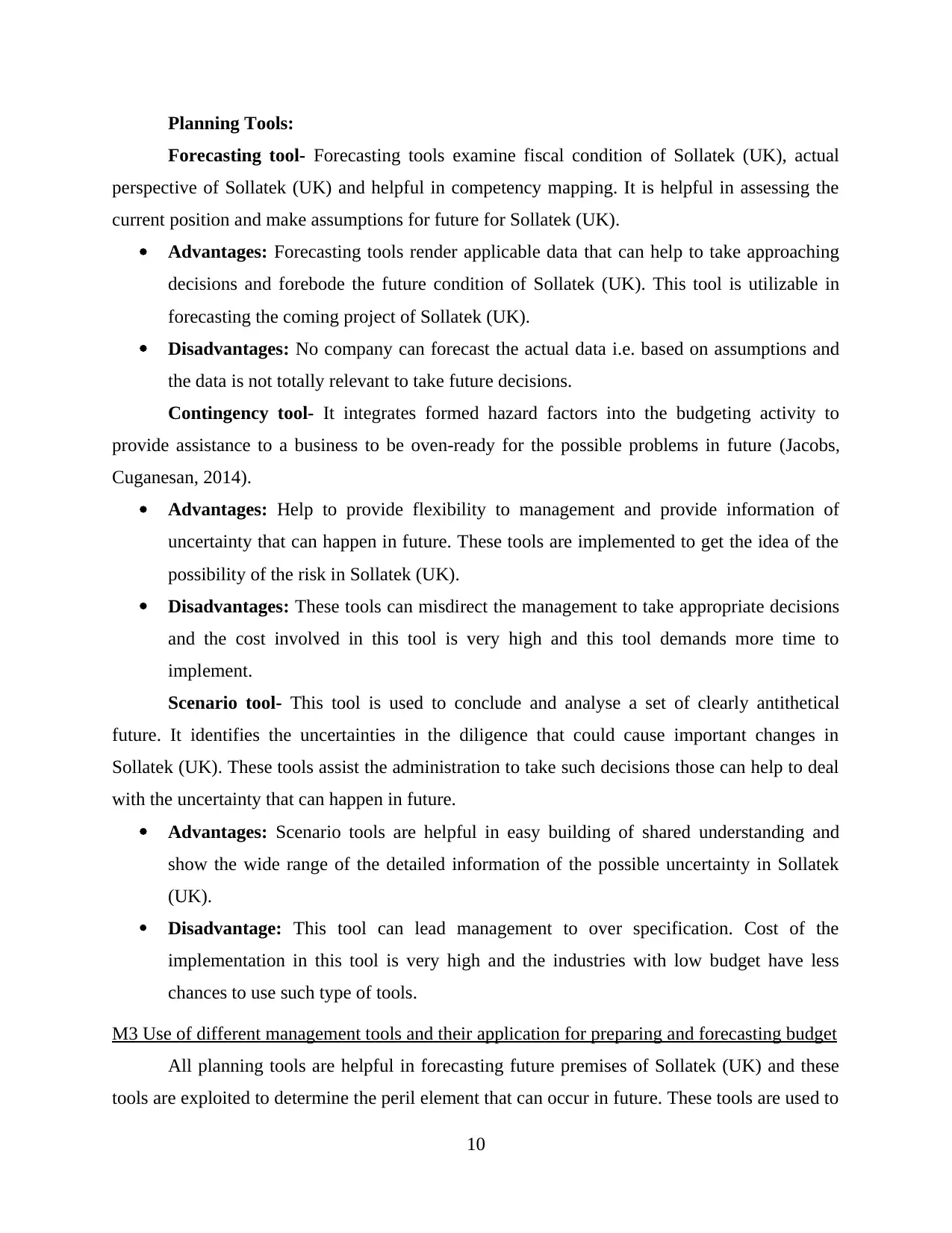
Planning Tools:
Forecasting tool- Forecasting tools examine fiscal condition of Sollatek (UK), actual
perspective of Sollatek (UK) and helpful in competency mapping. It is helpful in assessing the
current position and make assumptions for future for Sollatek (UK).
Advantages: Forecasting tools render applicable data that can help to take approaching
decisions and forebode the future condition of Sollatek (UK). This tool is utilizable in
forecasting the coming project of Sollatek (UK).
Disadvantages: No company can forecast the actual data i.e. based on assumptions and
the data is not totally relevant to take future decisions.
Contingency tool- It integrates formed hazard factors into the budgeting activity to
provide assistance to a business to be oven-ready for the possible problems in future (Jacobs,
Cuganesan, 2014).
Advantages: Help to provide flexibility to management and provide information of
uncertainty that can happen in future. These tools are implemented to get the idea of the
possibility of the risk in Sollatek (UK).
Disadvantages: These tools can misdirect the management to take appropriate decisions
and the cost involved in this tool is very high and this tool demands more time to
implement.
Scenario tool- This tool is used to conclude and analyse a set of clearly antithetical
future. It identifies the uncertainties in the diligence that could cause important changes in
Sollatek (UK). These tools assist the administration to take such decisions those can help to deal
with the uncertainty that can happen in future.
Advantages: Scenario tools are helpful in easy building of shared understanding and
show the wide range of the detailed information of the possible uncertainty in Sollatek
(UK).
Disadvantage: This tool can lead management to over specification. Cost of the
implementation in this tool is very high and the industries with low budget have less
chances to use such type of tools.
M3 Use of different management tools and their application for preparing and forecasting budget
All planning tools are helpful in forecasting future premises of Sollatek (UK) and these
tools are exploited to determine the peril element that can occur in future. These tools are used to
10
Forecasting tool- Forecasting tools examine fiscal condition of Sollatek (UK), actual
perspective of Sollatek (UK) and helpful in competency mapping. It is helpful in assessing the
current position and make assumptions for future for Sollatek (UK).
Advantages: Forecasting tools render applicable data that can help to take approaching
decisions and forebode the future condition of Sollatek (UK). This tool is utilizable in
forecasting the coming project of Sollatek (UK).
Disadvantages: No company can forecast the actual data i.e. based on assumptions and
the data is not totally relevant to take future decisions.
Contingency tool- It integrates formed hazard factors into the budgeting activity to
provide assistance to a business to be oven-ready for the possible problems in future (Jacobs,
Cuganesan, 2014).
Advantages: Help to provide flexibility to management and provide information of
uncertainty that can happen in future. These tools are implemented to get the idea of the
possibility of the risk in Sollatek (UK).
Disadvantages: These tools can misdirect the management to take appropriate decisions
and the cost involved in this tool is very high and this tool demands more time to
implement.
Scenario tool- This tool is used to conclude and analyse a set of clearly antithetical
future. It identifies the uncertainties in the diligence that could cause important changes in
Sollatek (UK). These tools assist the administration to take such decisions those can help to deal
with the uncertainty that can happen in future.
Advantages: Scenario tools are helpful in easy building of shared understanding and
show the wide range of the detailed information of the possible uncertainty in Sollatek
(UK).
Disadvantage: This tool can lead management to over specification. Cost of the
implementation in this tool is very high and the industries with low budget have less
chances to use such type of tools.
M3 Use of different management tools and their application for preparing and forecasting budget
All planning tools are helpful in forecasting future premises of Sollatek (UK) and these
tools are exploited to determine the peril element that can occur in future. These tools are used to
10
⊘ This is a preview!⊘
Do you want full access?
Subscribe today to unlock all pages.

Trusted by 1+ million students worldwide
1 out of 17
Related Documents
Your All-in-One AI-Powered Toolkit for Academic Success.
+13062052269
info@desklib.com
Available 24*7 on WhatsApp / Email
![[object Object]](/_next/static/media/star-bottom.7253800d.svg)
Unlock your academic potential
Copyright © 2020–2025 A2Z Services. All Rights Reserved. Developed and managed by ZUCOL.





